House Renovation: Project Management and Risk Analysis
VerifiedAdded on 2023/01/18
|16
|4271
|99
AI Summary
This report addresses the various aspects of project management and leadership skills like planning, management and leadership. It also discusses the different tools and methods used for analysis of the project and planning it in an efficient manner. It also analyses the risks related to the renovation project, ways to analyse said risks, its management and coming up with solutions for the risks.
Contribute Materials
Your contribution can guide someone’s learning journey. Share your
documents today.

1
House Renovation
House Renovation
Secure Best Marks with AI Grader
Need help grading? Try our AI Grader for instant feedback on your assignments.
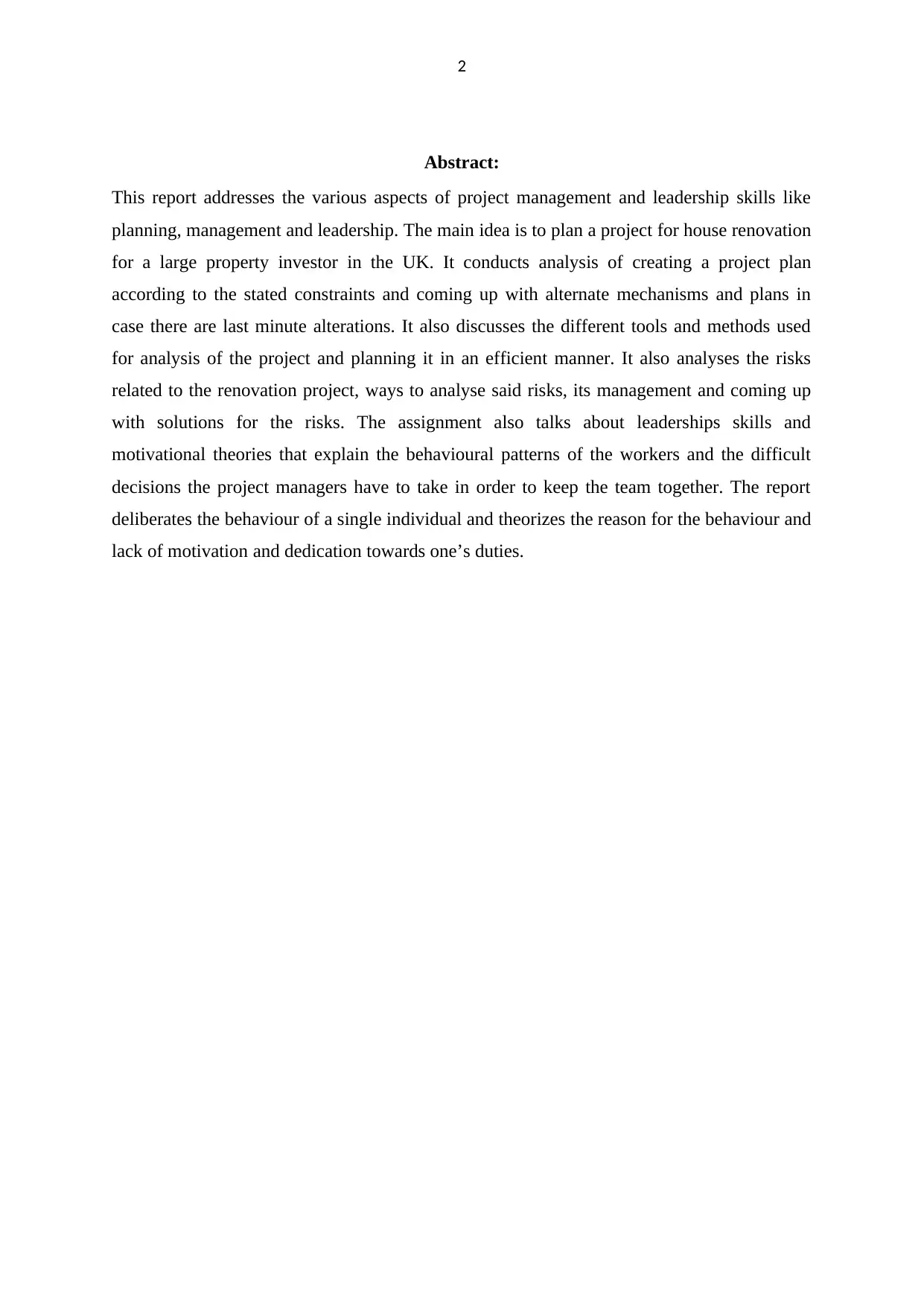
2
Abstract:
This report addresses the various aspects of project management and leadership skills like
planning, management and leadership. The main idea is to plan a project for house renovation
for a large property investor in the UK. It conducts analysis of creating a project plan
according to the stated constraints and coming up with alternate mechanisms and plans in
case there are last minute alterations. It also discusses the different tools and methods used
for analysis of the project and planning it in an efficient manner. It also analyses the risks
related to the renovation project, ways to analyse said risks, its management and coming up
with solutions for the risks. The assignment also talks about leaderships skills and
motivational theories that explain the behavioural patterns of the workers and the difficult
decisions the project managers have to take in order to keep the team together. The report
deliberates the behaviour of a single individual and theorizes the reason for the behaviour and
lack of motivation and dedication towards one’s duties.
Abstract:
This report addresses the various aspects of project management and leadership skills like
planning, management and leadership. The main idea is to plan a project for house renovation
for a large property investor in the UK. It conducts analysis of creating a project plan
according to the stated constraints and coming up with alternate mechanisms and plans in
case there are last minute alterations. It also discusses the different tools and methods used
for analysis of the project and planning it in an efficient manner. It also analyses the risks
related to the renovation project, ways to analyse said risks, its management and coming up
with solutions for the risks. The assignment also talks about leaderships skills and
motivational theories that explain the behavioural patterns of the workers and the difficult
decisions the project managers have to take in order to keep the team together. The report
deliberates the behaviour of a single individual and theorizes the reason for the behaviour and
lack of motivation and dedication towards one’s duties.

3
Table of Contents
Part 1: Critical Path Analysis 4
Part 2 Risk analysis and Management 8
Part 3: Reasons for Kevin’s lack of motivation 13
Reference 15
Table of Contents
Part 1: Critical Path Analysis 4
Part 2 Risk analysis and Management 8
Part 3: Reasons for Kevin’s lack of motivation 13
Reference 15
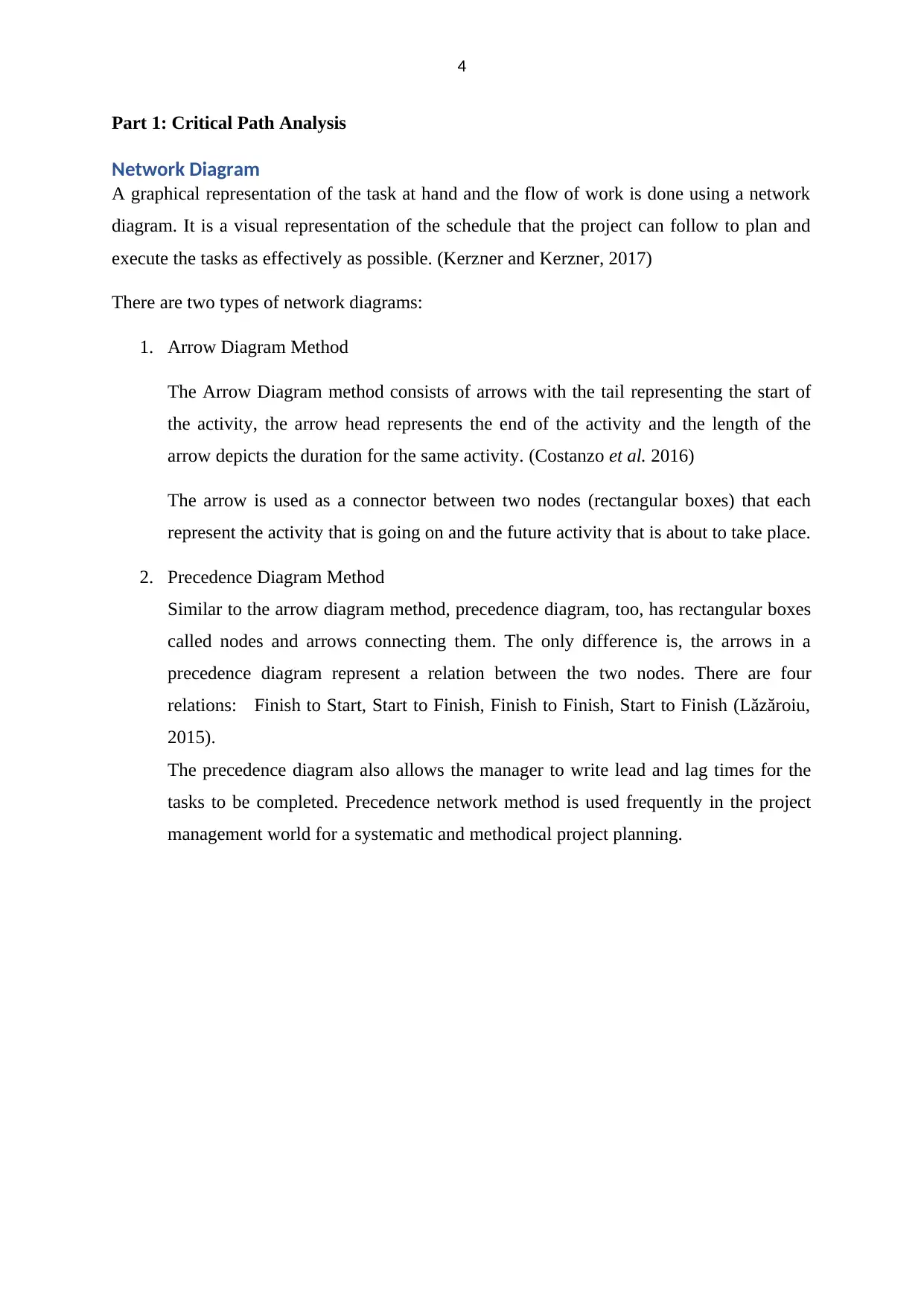
4
Part 1: Critical Path Analysis
Network Diagram
A graphical representation of the task at hand and the flow of work is done using a network
diagram. It is a visual representation of the schedule that the project can follow to plan and
execute the tasks as effectively as possible. (Kerzner and Kerzner, 2017)
There are two types of network diagrams:
1. Arrow Diagram Method
The Arrow Diagram method consists of arrows with the tail representing the start of
the activity, the arrow head represents the end of the activity and the length of the
arrow depicts the duration for the same activity. (Costanzo et al. 2016)
The arrow is used as a connector between two nodes (rectangular boxes) that each
represent the activity that is going on and the future activity that is about to take place.
2. Precedence Diagram Method
Similar to the arrow diagram method, precedence diagram, too, has rectangular boxes
called nodes and arrows connecting them. The only difference is, the arrows in a
precedence diagram represent a relation between the two nodes. There are four
relations: Finish to Start, Start to Finish, Finish to Finish, Start to Finish (Lăzăroiu,
2015).
The precedence diagram also allows the manager to write lead and lag times for the
tasks to be completed. Precedence network method is used frequently in the project
management world for a systematic and methodical project planning.
Part 1: Critical Path Analysis
Network Diagram
A graphical representation of the task at hand and the flow of work is done using a network
diagram. It is a visual representation of the schedule that the project can follow to plan and
execute the tasks as effectively as possible. (Kerzner and Kerzner, 2017)
There are two types of network diagrams:
1. Arrow Diagram Method
The Arrow Diagram method consists of arrows with the tail representing the start of
the activity, the arrow head represents the end of the activity and the length of the
arrow depicts the duration for the same activity. (Costanzo et al. 2016)
The arrow is used as a connector between two nodes (rectangular boxes) that each
represent the activity that is going on and the future activity that is about to take place.
2. Precedence Diagram Method
Similar to the arrow diagram method, precedence diagram, too, has rectangular boxes
called nodes and arrows connecting them. The only difference is, the arrows in a
precedence diagram represent a relation between the two nodes. There are four
relations: Finish to Start, Start to Finish, Finish to Finish, Start to Finish (Lăzăroiu,
2015).
The precedence diagram also allows the manager to write lead and lag times for the
tasks to be completed. Precedence network method is used frequently in the project
management world for a systematic and methodical project planning.
Secure Best Marks with AI Grader
Need help grading? Try our AI Grader for instant feedback on your assignments.
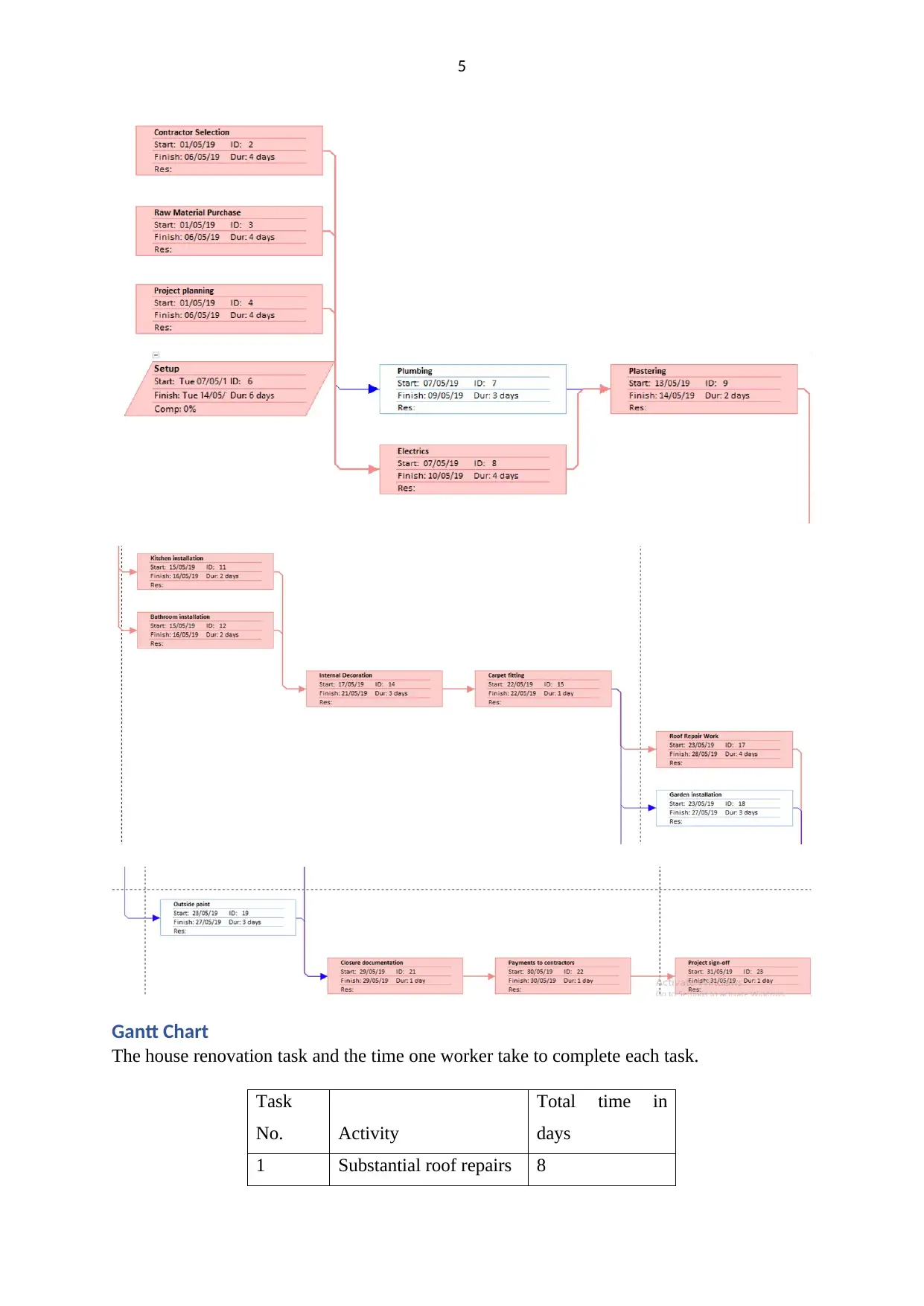
5
Gantt Chart
The house renovation task and the time one worker take to complete each task.
Task
No. Activity
Total time in
days
1 Substantial roof repairs 8
Gantt Chart
The house renovation task and the time one worker take to complete each task.
Task
No. Activity
Total time in
days
1 Substantial roof repairs 8
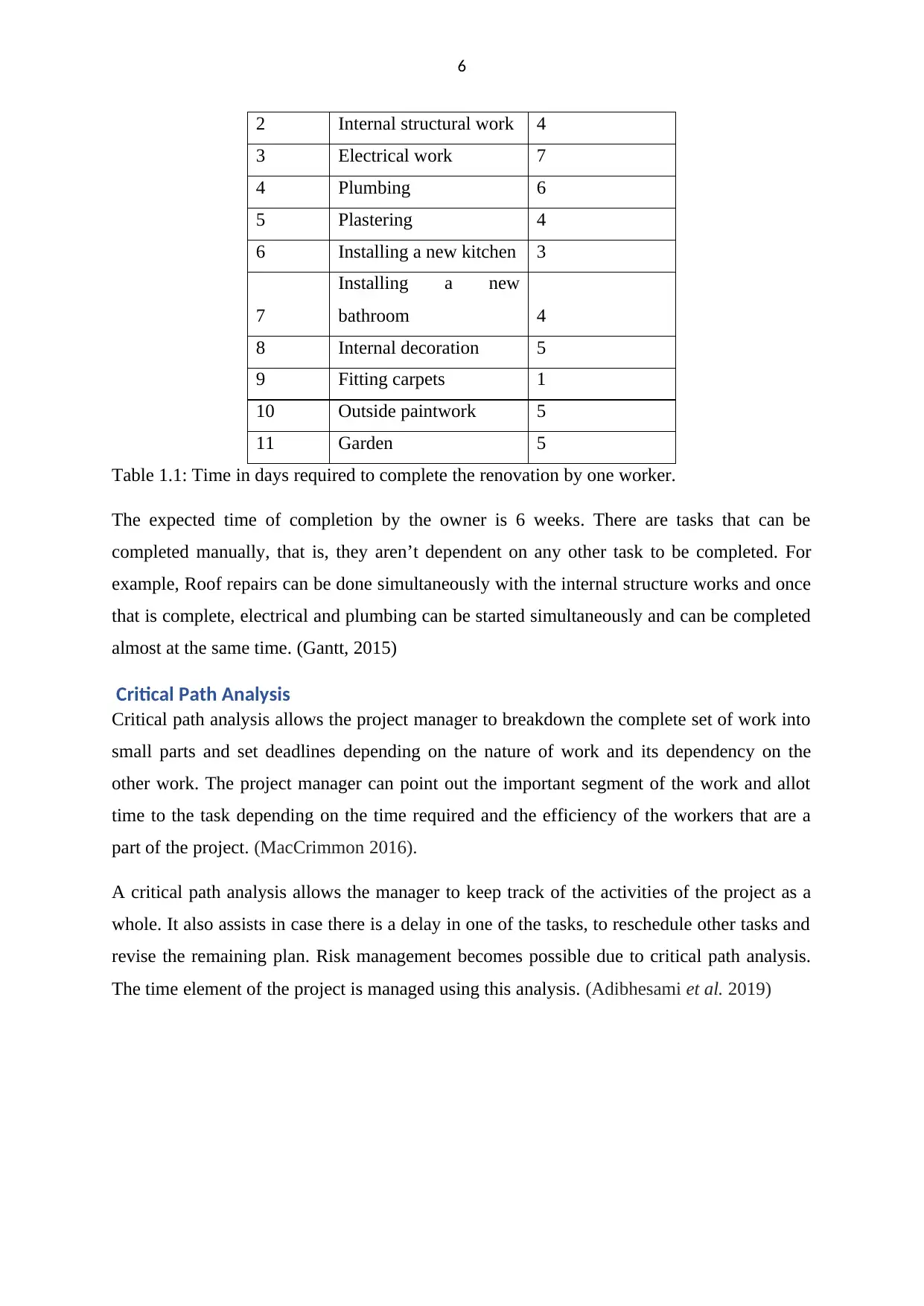
6
2 Internal structural work 4
3 Electrical work 7
4 Plumbing 6
5 Plastering 4
6 Installing a new kitchen 3
7
Installing a new
bathroom 4
8 Internal decoration 5
9 Fitting carpets 1
10 Outside paintwork 5
11 Garden 5
Table 1.1: Time in days required to complete the renovation by one worker.
The expected time of completion by the owner is 6 weeks. There are tasks that can be
completed manually, that is, they aren’t dependent on any other task to be completed. For
example, Roof repairs can be done simultaneously with the internal structure works and once
that is complete, electrical and plumbing can be started simultaneously and can be completed
almost at the same time. (Gantt, 2015)
Critical Path Analysis
Critical path analysis allows the project manager to breakdown the complete set of work into
small parts and set deadlines depending on the nature of work and its dependency on the
other work. The project manager can point out the important segment of the work and allot
time to the task depending on the time required and the efficiency of the workers that are a
part of the project. (MacCrimmon 2016).
A critical path analysis allows the manager to keep track of the activities of the project as a
whole. It also assists in case there is a delay in one of the tasks, to reschedule other tasks and
revise the remaining plan. Risk management becomes possible due to critical path analysis.
The time element of the project is managed using this analysis. (Adibhesami et al. 2019)
2 Internal structural work 4
3 Electrical work 7
4 Plumbing 6
5 Plastering 4
6 Installing a new kitchen 3
7
Installing a new
bathroom 4
8 Internal decoration 5
9 Fitting carpets 1
10 Outside paintwork 5
11 Garden 5
Table 1.1: Time in days required to complete the renovation by one worker.
The expected time of completion by the owner is 6 weeks. There are tasks that can be
completed manually, that is, they aren’t dependent on any other task to be completed. For
example, Roof repairs can be done simultaneously with the internal structure works and once
that is complete, electrical and plumbing can be started simultaneously and can be completed
almost at the same time. (Gantt, 2015)
Critical Path Analysis
Critical path analysis allows the project manager to breakdown the complete set of work into
small parts and set deadlines depending on the nature of work and its dependency on the
other work. The project manager can point out the important segment of the work and allot
time to the task depending on the time required and the efficiency of the workers that are a
part of the project. (MacCrimmon 2016).
A critical path analysis allows the manager to keep track of the activities of the project as a
whole. It also assists in case there is a delay in one of the tasks, to reschedule other tasks and
revise the remaining plan. Risk management becomes possible due to critical path analysis.
The time element of the project is managed using this analysis. (Adibhesami et al. 2019)
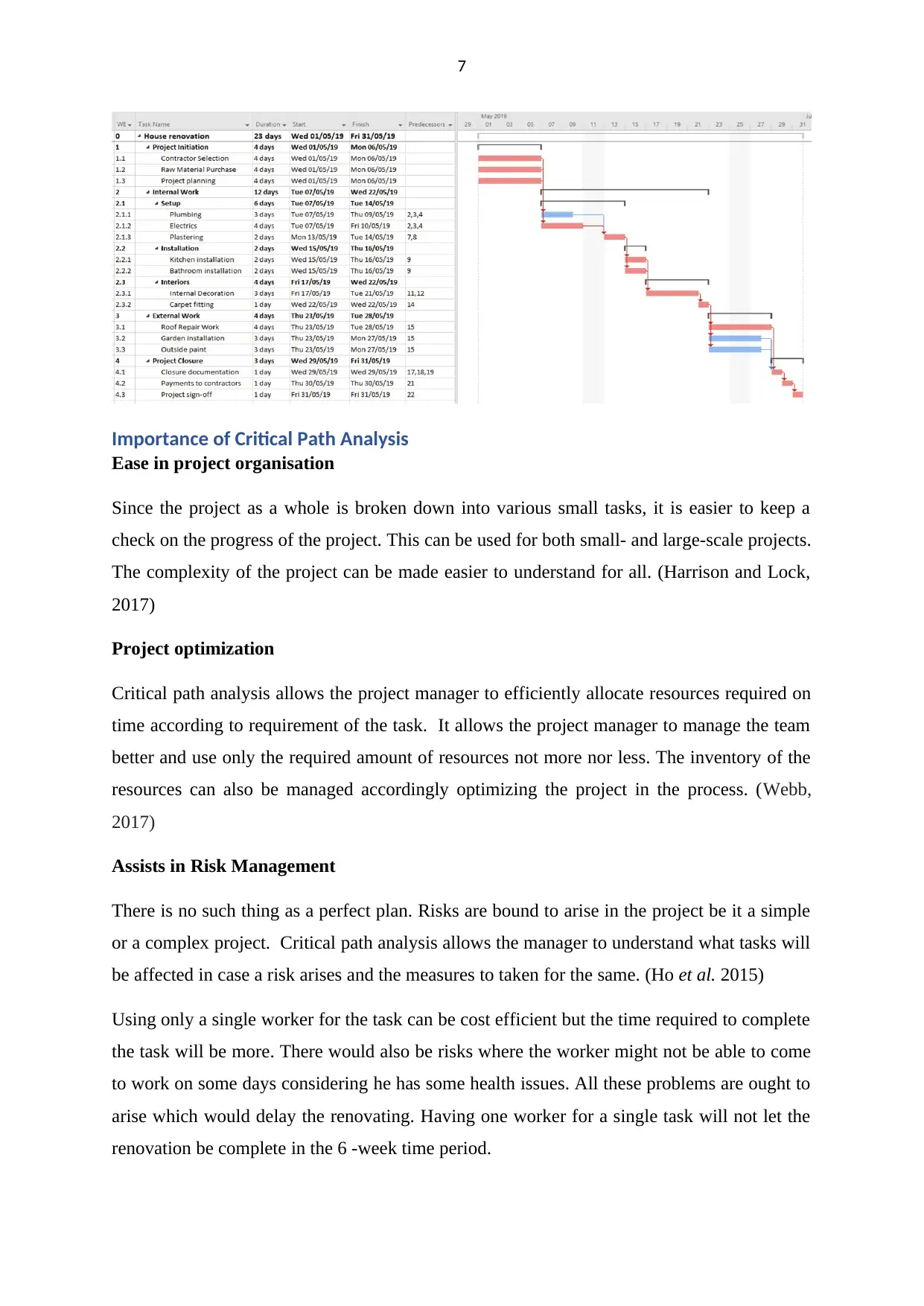
7
Importance of Critical Path Analysis
Ease in project organisation
Since the project as a whole is broken down into various small tasks, it is easier to keep a
check on the progress of the project. This can be used for both small- and large-scale projects.
The complexity of the project can be made easier to understand for all. (Harrison and Lock,
2017)
Project optimization
Critical path analysis allows the project manager to efficiently allocate resources required on
time according to requirement of the task. It allows the project manager to manage the team
better and use only the required amount of resources not more nor less. The inventory of the
resources can also be managed accordingly optimizing the project in the process. (Webb,
2017)
Assists in Risk Management
There is no such thing as a perfect plan. Risks are bound to arise in the project be it a simple
or a complex project. Critical path analysis allows the manager to understand what tasks will
be affected in case a risk arises and the measures to taken for the same. (Ho et al. 2015)
Using only a single worker for the task can be cost efficient but the time required to complete
the task will be more. There would also be risks where the worker might not be able to come
to work on some days considering he has some health issues. All these problems are ought to
arise which would delay the renovating. Having one worker for a single task will not let the
renovation be complete in the 6 -week time period.
Importance of Critical Path Analysis
Ease in project organisation
Since the project as a whole is broken down into various small tasks, it is easier to keep a
check on the progress of the project. This can be used for both small- and large-scale projects.
The complexity of the project can be made easier to understand for all. (Harrison and Lock,
2017)
Project optimization
Critical path analysis allows the project manager to efficiently allocate resources required on
time according to requirement of the task. It allows the project manager to manage the team
better and use only the required amount of resources not more nor less. The inventory of the
resources can also be managed accordingly optimizing the project in the process. (Webb,
2017)
Assists in Risk Management
There is no such thing as a perfect plan. Risks are bound to arise in the project be it a simple
or a complex project. Critical path analysis allows the manager to understand what tasks will
be affected in case a risk arises and the measures to taken for the same. (Ho et al. 2015)
Using only a single worker for the task can be cost efficient but the time required to complete
the task will be more. There would also be risks where the worker might not be able to come
to work on some days considering he has some health issues. All these problems are ought to
arise which would delay the renovating. Having one worker for a single task will not let the
renovation be complete in the 6 -week time period.
Paraphrase This Document
Need a fresh take? Get an instant paraphrase of this document with our AI Paraphraser
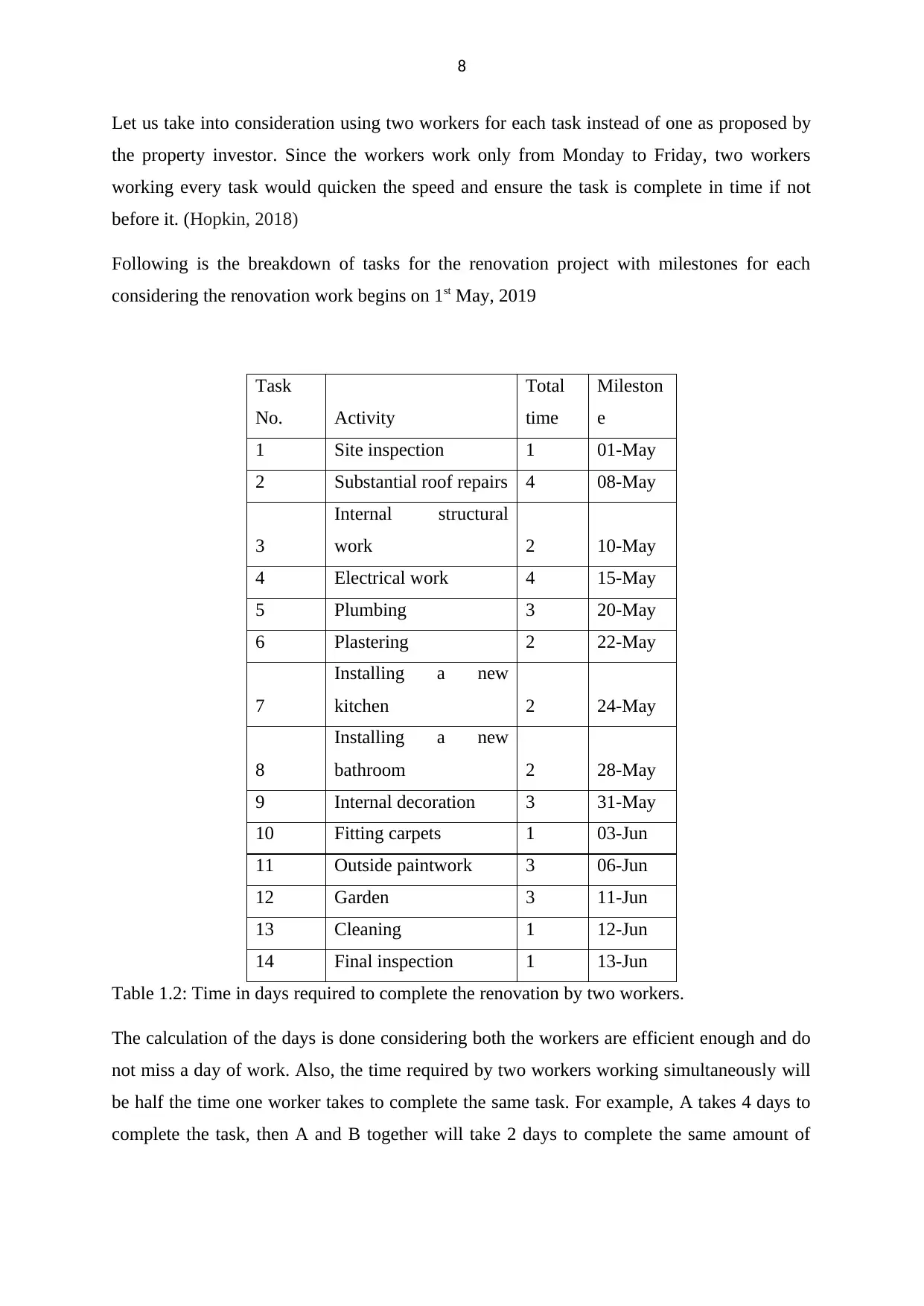
8
Let us take into consideration using two workers for each task instead of one as proposed by
the property investor. Since the workers work only from Monday to Friday, two workers
working every task would quicken the speed and ensure the task is complete in time if not
before it. (Hopkin, 2018)
Following is the breakdown of tasks for the renovation project with milestones for each
considering the renovation work begins on 1st May, 2019
Task
No. Activity
Total
time
Mileston
e
1 Site inspection 1 01-May
2 Substantial roof repairs 4 08-May
3
Internal structural
work 2 10-May
4 Electrical work 4 15-May
5 Plumbing 3 20-May
6 Plastering 2 22-May
7
Installing a new
kitchen 2 24-May
8
Installing a new
bathroom 2 28-May
9 Internal decoration 3 31-May
10 Fitting carpets 1 03-Jun
11 Outside paintwork 3 06-Jun
12 Garden 3 11-Jun
13 Cleaning 1 12-Jun
14 Final inspection 1 13-Jun
Table 1.2: Time in days required to complete the renovation by two workers.
The calculation of the days is done considering both the workers are efficient enough and do
not miss a day of work. Also, the time required by two workers working simultaneously will
be half the time one worker takes to complete the same task. For example, A takes 4 days to
complete the task, then A and B together will take 2 days to complete the same amount of
Let us take into consideration using two workers for each task instead of one as proposed by
the property investor. Since the workers work only from Monday to Friday, two workers
working every task would quicken the speed and ensure the task is complete in time if not
before it. (Hopkin, 2018)
Following is the breakdown of tasks for the renovation project with milestones for each
considering the renovation work begins on 1st May, 2019
Task
No. Activity
Total
time
Mileston
e
1 Site inspection 1 01-May
2 Substantial roof repairs 4 08-May
3
Internal structural
work 2 10-May
4 Electrical work 4 15-May
5 Plumbing 3 20-May
6 Plastering 2 22-May
7
Installing a new
kitchen 2 24-May
8
Installing a new
bathroom 2 28-May
9 Internal decoration 3 31-May
10 Fitting carpets 1 03-Jun
11 Outside paintwork 3 06-Jun
12 Garden 3 11-Jun
13 Cleaning 1 12-Jun
14 Final inspection 1 13-Jun
Table 1.2: Time in days required to complete the renovation by two workers.
The calculation of the days is done considering both the workers are efficient enough and do
not miss a day of work. Also, the time required by two workers working simultaneously will
be half the time one worker takes to complete the same task. For example, A takes 4 days to
complete the task, then A and B together will take 2 days to complete the same amount of
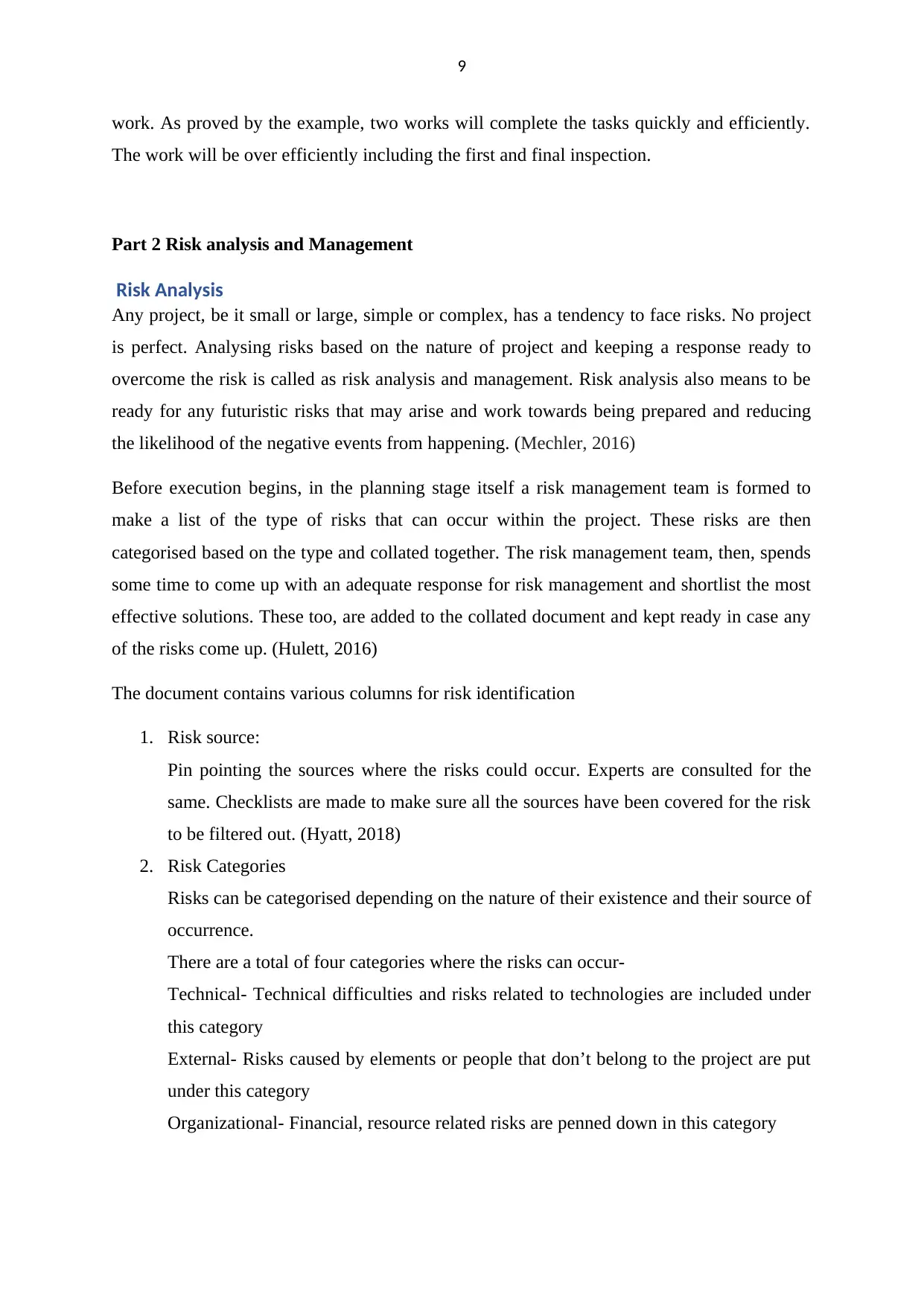
9
work. As proved by the example, two works will complete the tasks quickly and efficiently.
The work will be over efficiently including the first and final inspection.
Part 2 Risk analysis and Management
Risk Analysis
Any project, be it small or large, simple or complex, has a tendency to face risks. No project
is perfect. Analysing risks based on the nature of project and keeping a response ready to
overcome the risk is called as risk analysis and management. Risk analysis also means to be
ready for any futuristic risks that may arise and work towards being prepared and reducing
the likelihood of the negative events from happening. (Mechler, 2016)
Before execution begins, in the planning stage itself a risk management team is formed to
make a list of the type of risks that can occur within the project. These risks are then
categorised based on the type and collated together. The risk management team, then, spends
some time to come up with an adequate response for risk management and shortlist the most
effective solutions. These too, are added to the collated document and kept ready in case any
of the risks come up. (Hulett, 2016)
The document contains various columns for risk identification
1. Risk source:
Pin pointing the sources where the risks could occur. Experts are consulted for the
same. Checklists are made to make sure all the sources have been covered for the risk
to be filtered out. (Hyatt, 2018)
2. Risk Categories
Risks can be categorised depending on the nature of their existence and their source of
occurrence.
There are a total of four categories where the risks can occur-
Technical- Technical difficulties and risks related to technologies are included under
this category
External- Risks caused by elements or people that don’t belong to the project are put
under this category
Organizational- Financial, resource related risks are penned down in this category
work. As proved by the example, two works will complete the tasks quickly and efficiently.
The work will be over efficiently including the first and final inspection.
Part 2 Risk analysis and Management
Risk Analysis
Any project, be it small or large, simple or complex, has a tendency to face risks. No project
is perfect. Analysing risks based on the nature of project and keeping a response ready to
overcome the risk is called as risk analysis and management. Risk analysis also means to be
ready for any futuristic risks that may arise and work towards being prepared and reducing
the likelihood of the negative events from happening. (Mechler, 2016)
Before execution begins, in the planning stage itself a risk management team is formed to
make a list of the type of risks that can occur within the project. These risks are then
categorised based on the type and collated together. The risk management team, then, spends
some time to come up with an adequate response for risk management and shortlist the most
effective solutions. These too, are added to the collated document and kept ready in case any
of the risks come up. (Hulett, 2016)
The document contains various columns for risk identification
1. Risk source:
Pin pointing the sources where the risks could occur. Experts are consulted for the
same. Checklists are made to make sure all the sources have been covered for the risk
to be filtered out. (Hyatt, 2018)
2. Risk Categories
Risks can be categorised depending on the nature of their existence and their source of
occurrence.
There are a total of four categories where the risks can occur-
Technical- Technical difficulties and risks related to technologies are included under
this category
External- Risks caused by elements or people that don’t belong to the project are put
under this category
Organizational- Financial, resource related risks are penned down in this category
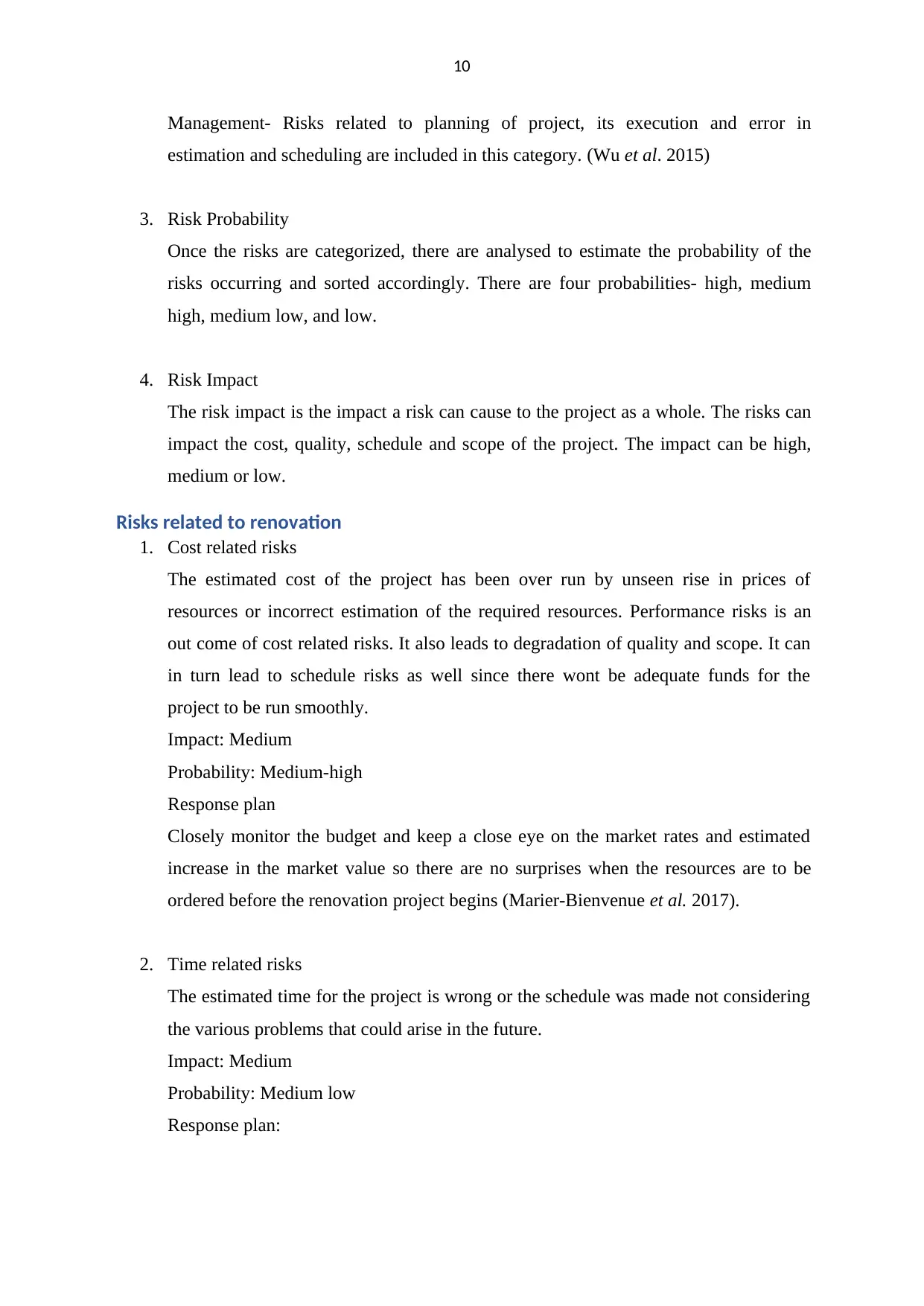
10
Management- Risks related to planning of project, its execution and error in
estimation and scheduling are included in this category. (Wu et al. 2015)
3. Risk Probability
Once the risks are categorized, there are analysed to estimate the probability of the
risks occurring and sorted accordingly. There are four probabilities- high, medium
high, medium low, and low.
4. Risk Impact
The risk impact is the impact a risk can cause to the project as a whole. The risks can
impact the cost, quality, schedule and scope of the project. The impact can be high,
medium or low.
Risks related to renovation
1. Cost related risks
The estimated cost of the project has been over run by unseen rise in prices of
resources or incorrect estimation of the required resources. Performance risks is an
out come of cost related risks. It also leads to degradation of quality and scope. It can
in turn lead to schedule risks as well since there wont be adequate funds for the
project to be run smoothly.
Impact: Medium
Probability: Medium-high
Response plan
Closely monitor the budget and keep a close eye on the market rates and estimated
increase in the market value so there are no surprises when the resources are to be
ordered before the renovation project begins (Marier-Bienvenue et al. 2017).
2. Time related risks
The estimated time for the project is wrong or the schedule was made not considering
the various problems that could arise in the future.
Impact: Medium
Probability: Medium low
Response plan:
Management- Risks related to planning of project, its execution and error in
estimation and scheduling are included in this category. (Wu et al. 2015)
3. Risk Probability
Once the risks are categorized, there are analysed to estimate the probability of the
risks occurring and sorted accordingly. There are four probabilities- high, medium
high, medium low, and low.
4. Risk Impact
The risk impact is the impact a risk can cause to the project as a whole. The risks can
impact the cost, quality, schedule and scope of the project. The impact can be high,
medium or low.
Risks related to renovation
1. Cost related risks
The estimated cost of the project has been over run by unseen rise in prices of
resources or incorrect estimation of the required resources. Performance risks is an
out come of cost related risks. It also leads to degradation of quality and scope. It can
in turn lead to schedule risks as well since there wont be adequate funds for the
project to be run smoothly.
Impact: Medium
Probability: Medium-high
Response plan
Closely monitor the budget and keep a close eye on the market rates and estimated
increase in the market value so there are no surprises when the resources are to be
ordered before the renovation project begins (Marier-Bienvenue et al. 2017).
2. Time related risks
The estimated time for the project is wrong or the schedule was made not considering
the various problems that could arise in the future.
Impact: Medium
Probability: Medium low
Response plan:
Secure Best Marks with AI Grader
Need help grading? Try our AI Grader for instant feedback on your assignments.
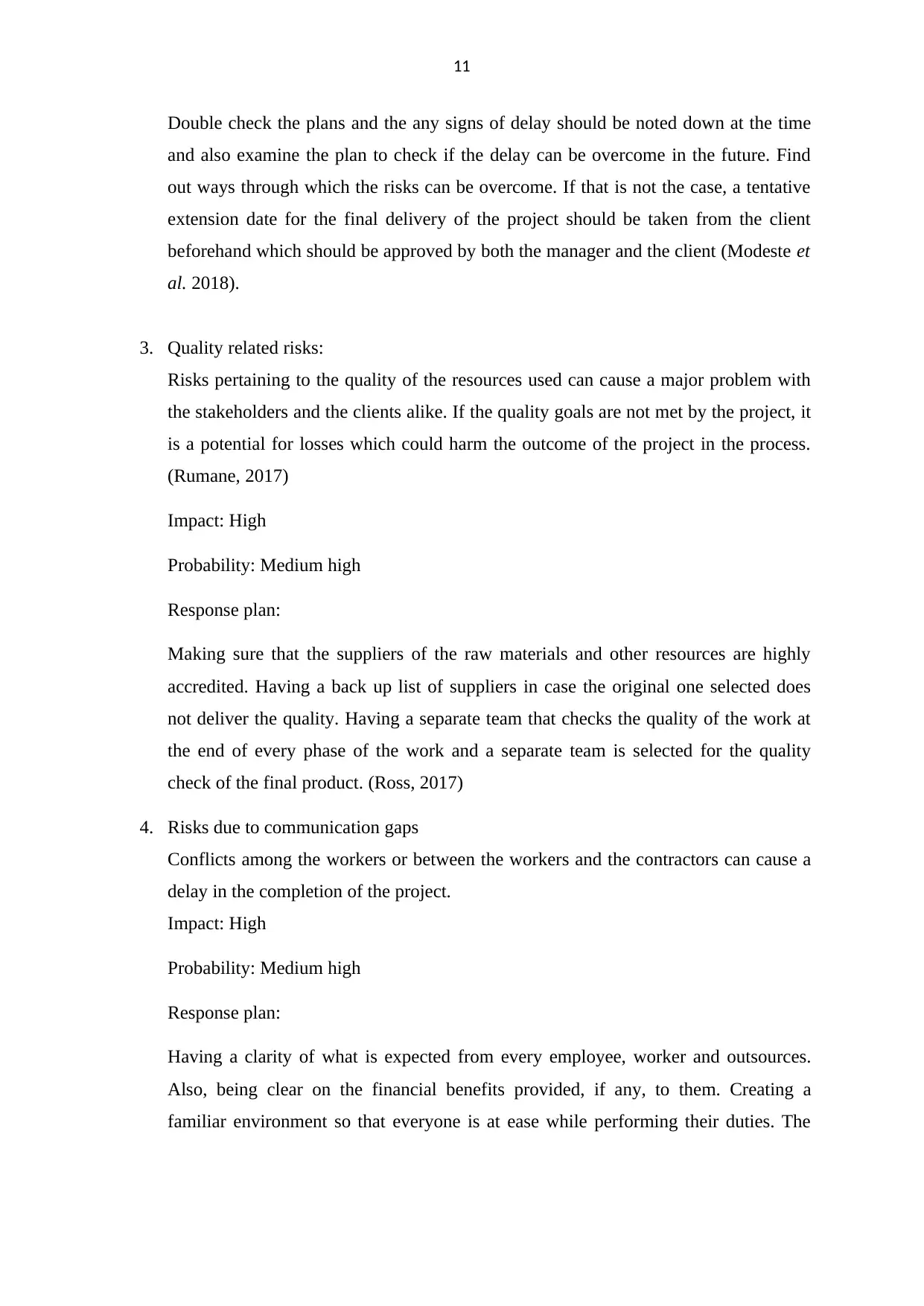
11
Double check the plans and the any signs of delay should be noted down at the time
and also examine the plan to check if the delay can be overcome in the future. Find
out ways through which the risks can be overcome. If that is not the case, a tentative
extension date for the final delivery of the project should be taken from the client
beforehand which should be approved by both the manager and the client (Modeste et
al. 2018).
3. Quality related risks:
Risks pertaining to the quality of the resources used can cause a major problem with
the stakeholders and the clients alike. If the quality goals are not met by the project, it
is a potential for losses which could harm the outcome of the project in the process.
(Rumane, 2017)
Impact: High
Probability: Medium high
Response plan:
Making sure that the suppliers of the raw materials and other resources are highly
accredited. Having a back up list of suppliers in case the original one selected does
not deliver the quality. Having a separate team that checks the quality of the work at
the end of every phase of the work and a separate team is selected for the quality
check of the final product. (Ross, 2017)
4. Risks due to communication gaps
Conflicts among the workers or between the workers and the contractors can cause a
delay in the completion of the project.
Impact: High
Probability: Medium high
Response plan:
Having a clarity of what is expected from every employee, worker and outsources.
Also, being clear on the financial benefits provided, if any, to them. Creating a
familiar environment so that everyone is at ease while performing their duties. The
Double check the plans and the any signs of delay should be noted down at the time
and also examine the plan to check if the delay can be overcome in the future. Find
out ways through which the risks can be overcome. If that is not the case, a tentative
extension date for the final delivery of the project should be taken from the client
beforehand which should be approved by both the manager and the client (Modeste et
al. 2018).
3. Quality related risks:
Risks pertaining to the quality of the resources used can cause a major problem with
the stakeholders and the clients alike. If the quality goals are not met by the project, it
is a potential for losses which could harm the outcome of the project in the process.
(Rumane, 2017)
Impact: High
Probability: Medium high
Response plan:
Making sure that the suppliers of the raw materials and other resources are highly
accredited. Having a back up list of suppliers in case the original one selected does
not deliver the quality. Having a separate team that checks the quality of the work at
the end of every phase of the work and a separate team is selected for the quality
check of the final product. (Ross, 2017)
4. Risks due to communication gaps
Conflicts among the workers or between the workers and the contractors can cause a
delay in the completion of the project.
Impact: High
Probability: Medium high
Response plan:
Having a clarity of what is expected from every employee, worker and outsources.
Also, being clear on the financial benefits provided, if any, to them. Creating a
familiar environment so that everyone is at ease while performing their duties. The
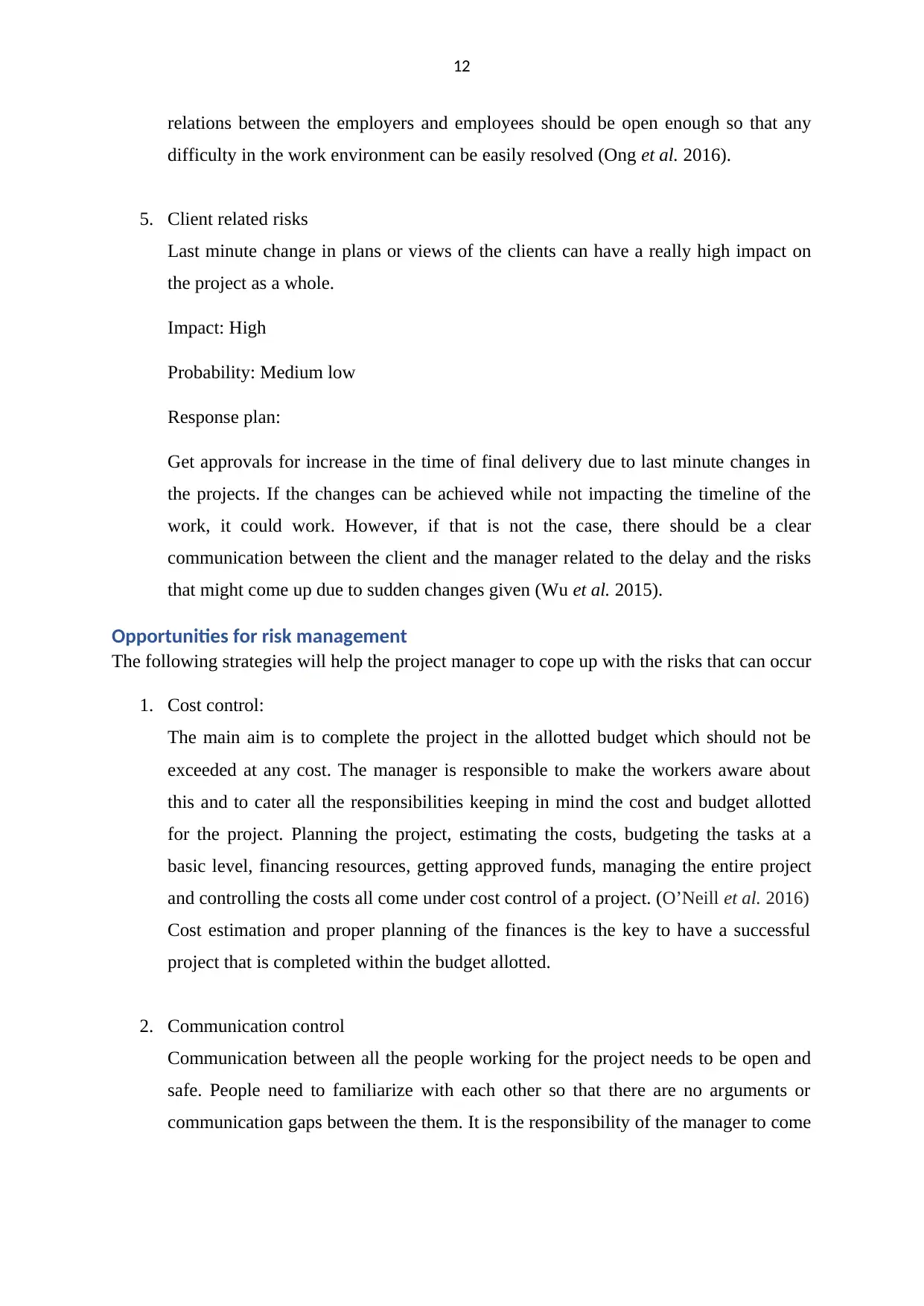
12
relations between the employers and employees should be open enough so that any
difficulty in the work environment can be easily resolved (Ong et al. 2016).
5. Client related risks
Last minute change in plans or views of the clients can have a really high impact on
the project as a whole.
Impact: High
Probability: Medium low
Response plan:
Get approvals for increase in the time of final delivery due to last minute changes in
the projects. If the changes can be achieved while not impacting the timeline of the
work, it could work. However, if that is not the case, there should be a clear
communication between the client and the manager related to the delay and the risks
that might come up due to sudden changes given (Wu et al. 2015).
Opportunities for risk management
The following strategies will help the project manager to cope up with the risks that can occur
1. Cost control:
The main aim is to complete the project in the allotted budget which should not be
exceeded at any cost. The manager is responsible to make the workers aware about
this and to cater all the responsibilities keeping in mind the cost and budget allotted
for the project. Planning the project, estimating the costs, budgeting the tasks at a
basic level, financing resources, getting approved funds, managing the entire project
and controlling the costs all come under cost control of a project. (O’Neill et al. 2016)
Cost estimation and proper planning of the finances is the key to have a successful
project that is completed within the budget allotted.
2. Communication control
Communication between all the people working for the project needs to be open and
safe. People need to familiarize with each other so that there are no arguments or
communication gaps between the them. It is the responsibility of the manager to come
relations between the employers and employees should be open enough so that any
difficulty in the work environment can be easily resolved (Ong et al. 2016).
5. Client related risks
Last minute change in plans or views of the clients can have a really high impact on
the project as a whole.
Impact: High
Probability: Medium low
Response plan:
Get approvals for increase in the time of final delivery due to last minute changes in
the projects. If the changes can be achieved while not impacting the timeline of the
work, it could work. However, if that is not the case, there should be a clear
communication between the client and the manager related to the delay and the risks
that might come up due to sudden changes given (Wu et al. 2015).
Opportunities for risk management
The following strategies will help the project manager to cope up with the risks that can occur
1. Cost control:
The main aim is to complete the project in the allotted budget which should not be
exceeded at any cost. The manager is responsible to make the workers aware about
this and to cater all the responsibilities keeping in mind the cost and budget allotted
for the project. Planning the project, estimating the costs, budgeting the tasks at a
basic level, financing resources, getting approved funds, managing the entire project
and controlling the costs all come under cost control of a project. (O’Neill et al. 2016)
Cost estimation and proper planning of the finances is the key to have a successful
project that is completed within the budget allotted.
2. Communication control
Communication between all the people working for the project needs to be open and
safe. People need to familiarize with each other so that there are no arguments or
communication gaps between the them. It is the responsibility of the manager to come
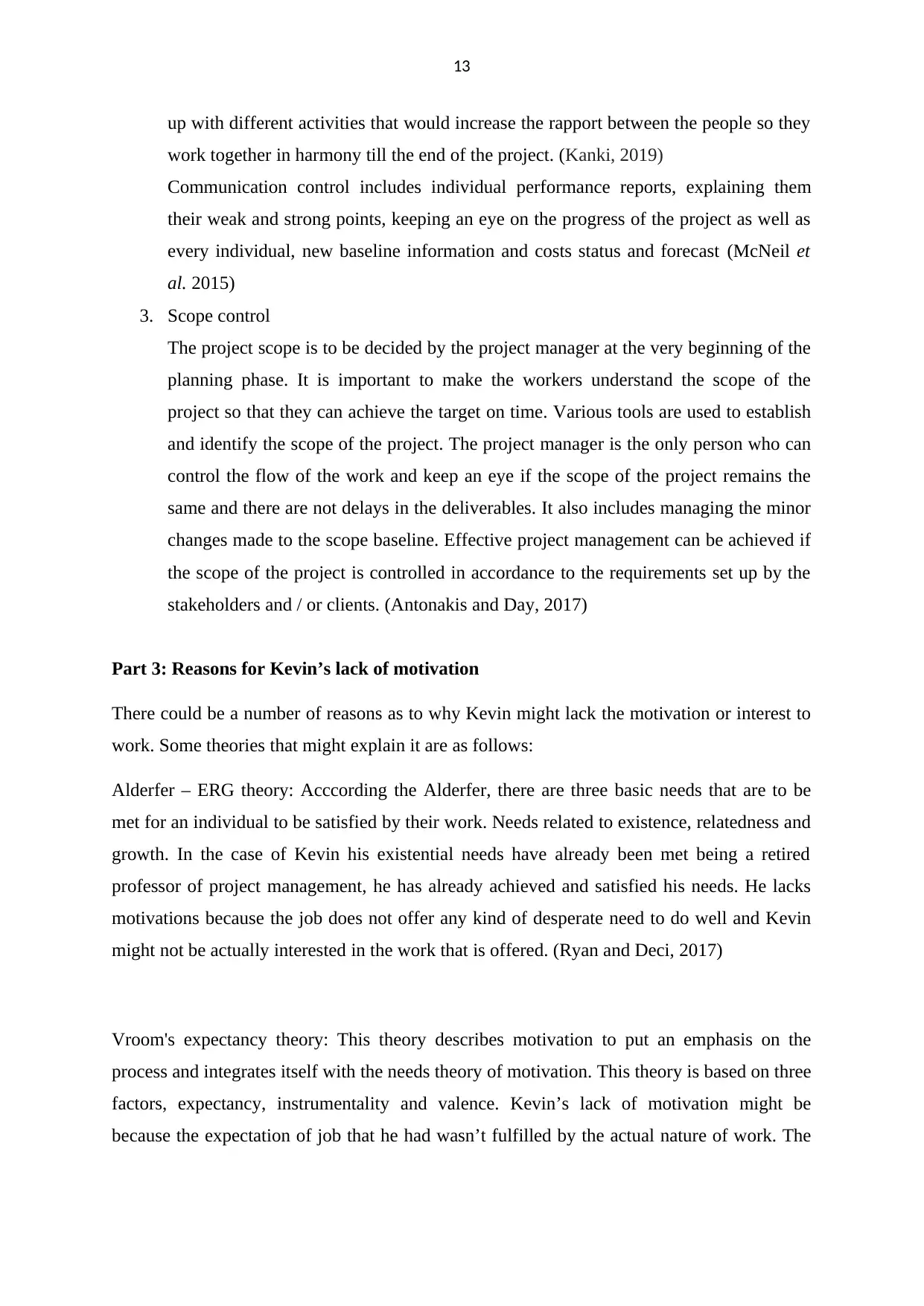
13
up with different activities that would increase the rapport between the people so they
work together in harmony till the end of the project. (Kanki, 2019)
Communication control includes individual performance reports, explaining them
their weak and strong points, keeping an eye on the progress of the project as well as
every individual, new baseline information and costs status and forecast (McNeil et
al. 2015)
3. Scope control
The project scope is to be decided by the project manager at the very beginning of the
planning phase. It is important to make the workers understand the scope of the
project so that they can achieve the target on time. Various tools are used to establish
and identify the scope of the project. The project manager is the only person who can
control the flow of the work and keep an eye if the scope of the project remains the
same and there are not delays in the deliverables. It also includes managing the minor
changes made to the scope baseline. Effective project management can be achieved if
the scope of the project is controlled in accordance to the requirements set up by the
stakeholders and / or clients. (Antonakis and Day, 2017)
Part 3: Reasons for Kevin’s lack of motivation
There could be a number of reasons as to why Kevin might lack the motivation or interest to
work. Some theories that might explain it are as follows:
Alderfer – ERG theory: Acccording the Alderfer, there are three basic needs that are to be
met for an individual to be satisfied by their work. Needs related to existence, relatedness and
growth. In the case of Kevin his existential needs have already been met being a retired
professor of project management, he has already achieved and satisfied his needs. He lacks
motivations because the job does not offer any kind of desperate need to do well and Kevin
might not be actually interested in the work that is offered. (Ryan and Deci, 2017)
Vroom's expectancy theory: This theory describes motivation to put an emphasis on the
process and integrates itself with the needs theory of motivation. This theory is based on three
factors, expectancy, instrumentality and valence. Kevin’s lack of motivation might be
because the expectation of job that he had wasn’t fulfilled by the actual nature of work. The
up with different activities that would increase the rapport between the people so they
work together in harmony till the end of the project. (Kanki, 2019)
Communication control includes individual performance reports, explaining them
their weak and strong points, keeping an eye on the progress of the project as well as
every individual, new baseline information and costs status and forecast (McNeil et
al. 2015)
3. Scope control
The project scope is to be decided by the project manager at the very beginning of the
planning phase. It is important to make the workers understand the scope of the
project so that they can achieve the target on time. Various tools are used to establish
and identify the scope of the project. The project manager is the only person who can
control the flow of the work and keep an eye if the scope of the project remains the
same and there are not delays in the deliverables. It also includes managing the minor
changes made to the scope baseline. Effective project management can be achieved if
the scope of the project is controlled in accordance to the requirements set up by the
stakeholders and / or clients. (Antonakis and Day, 2017)
Part 3: Reasons for Kevin’s lack of motivation
There could be a number of reasons as to why Kevin might lack the motivation or interest to
work. Some theories that might explain it are as follows:
Alderfer – ERG theory: Acccording the Alderfer, there are three basic needs that are to be
met for an individual to be satisfied by their work. Needs related to existence, relatedness and
growth. In the case of Kevin his existential needs have already been met being a retired
professor of project management, he has already achieved and satisfied his needs. He lacks
motivations because the job does not offer any kind of desperate need to do well and Kevin
might not be actually interested in the work that is offered. (Ryan and Deci, 2017)
Vroom's expectancy theory: This theory describes motivation to put an emphasis on the
process and integrates itself with the needs theory of motivation. This theory is based on three
factors, expectancy, instrumentality and valence. Kevin’s lack of motivation might be
because the expectation of job that he had wasn’t fulfilled by the actual nature of work. The
Paraphrase This Document
Need a fresh take? Get an instant paraphrase of this document with our AI Paraphraser
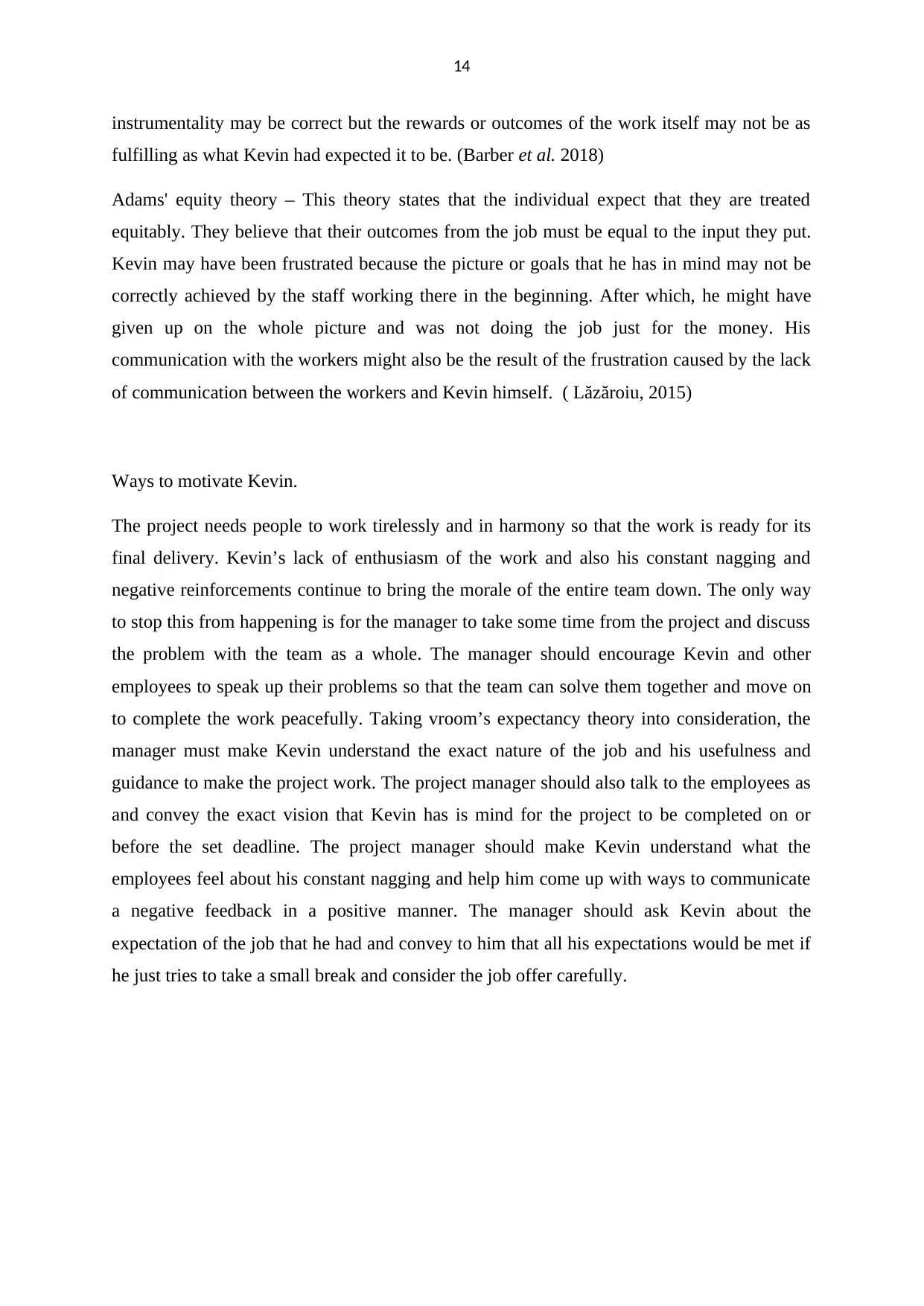
14
instrumentality may be correct but the rewards or outcomes of the work itself may not be as
fulfilling as what Kevin had expected it to be. (Barber et al. 2018)
Adams' equity theory – This theory states that the individual expect that they are treated
equitably. They believe that their outcomes from the job must be equal to the input they put.
Kevin may have been frustrated because the picture or goals that he has in mind may not be
correctly achieved by the staff working there in the beginning. After which, he might have
given up on the whole picture and was not doing the job just for the money. His
communication with the workers might also be the result of the frustration caused by the lack
of communication between the workers and Kevin himself. ( Lăzăroiu, 2015)
Ways to motivate Kevin.
The project needs people to work tirelessly and in harmony so that the work is ready for its
final delivery. Kevin’s lack of enthusiasm of the work and also his constant nagging and
negative reinforcements continue to bring the morale of the entire team down. The only way
to stop this from happening is for the manager to take some time from the project and discuss
the problem with the team as a whole. The manager should encourage Kevin and other
employees to speak up their problems so that the team can solve them together and move on
to complete the work peacefully. Taking vroom’s expectancy theory into consideration, the
manager must make Kevin understand the exact nature of the job and his usefulness and
guidance to make the project work. The project manager should also talk to the employees as
and convey the exact vision that Kevin has is mind for the project to be completed on or
before the set deadline. The project manager should make Kevin understand what the
employees feel about his constant nagging and help him come up with ways to communicate
a negative feedback in a positive manner. The manager should ask Kevin about the
expectation of the job that he had and convey to him that all his expectations would be met if
he just tries to take a small break and consider the job offer carefully.
instrumentality may be correct but the rewards or outcomes of the work itself may not be as
fulfilling as what Kevin had expected it to be. (Barber et al. 2018)
Adams' equity theory – This theory states that the individual expect that they are treated
equitably. They believe that their outcomes from the job must be equal to the input they put.
Kevin may have been frustrated because the picture or goals that he has in mind may not be
correctly achieved by the staff working there in the beginning. After which, he might have
given up on the whole picture and was not doing the job just for the money. His
communication with the workers might also be the result of the frustration caused by the lack
of communication between the workers and Kevin himself. ( Lăzăroiu, 2015)
Ways to motivate Kevin.
The project needs people to work tirelessly and in harmony so that the work is ready for its
final delivery. Kevin’s lack of enthusiasm of the work and also his constant nagging and
negative reinforcements continue to bring the morale of the entire team down. The only way
to stop this from happening is for the manager to take some time from the project and discuss
the problem with the team as a whole. The manager should encourage Kevin and other
employees to speak up their problems so that the team can solve them together and move on
to complete the work peacefully. Taking vroom’s expectancy theory into consideration, the
manager must make Kevin understand the exact nature of the job and his usefulness and
guidance to make the project work. The project manager should also talk to the employees as
and convey the exact vision that Kevin has is mind for the project to be completed on or
before the set deadline. The project manager should make Kevin understand what the
employees feel about his constant nagging and help him come up with ways to communicate
a negative feedback in a positive manner. The manager should ask Kevin about the
expectation of the job that he had and convey to him that all his expectations would be met if
he just tries to take a small break and consider the job offer carefully.
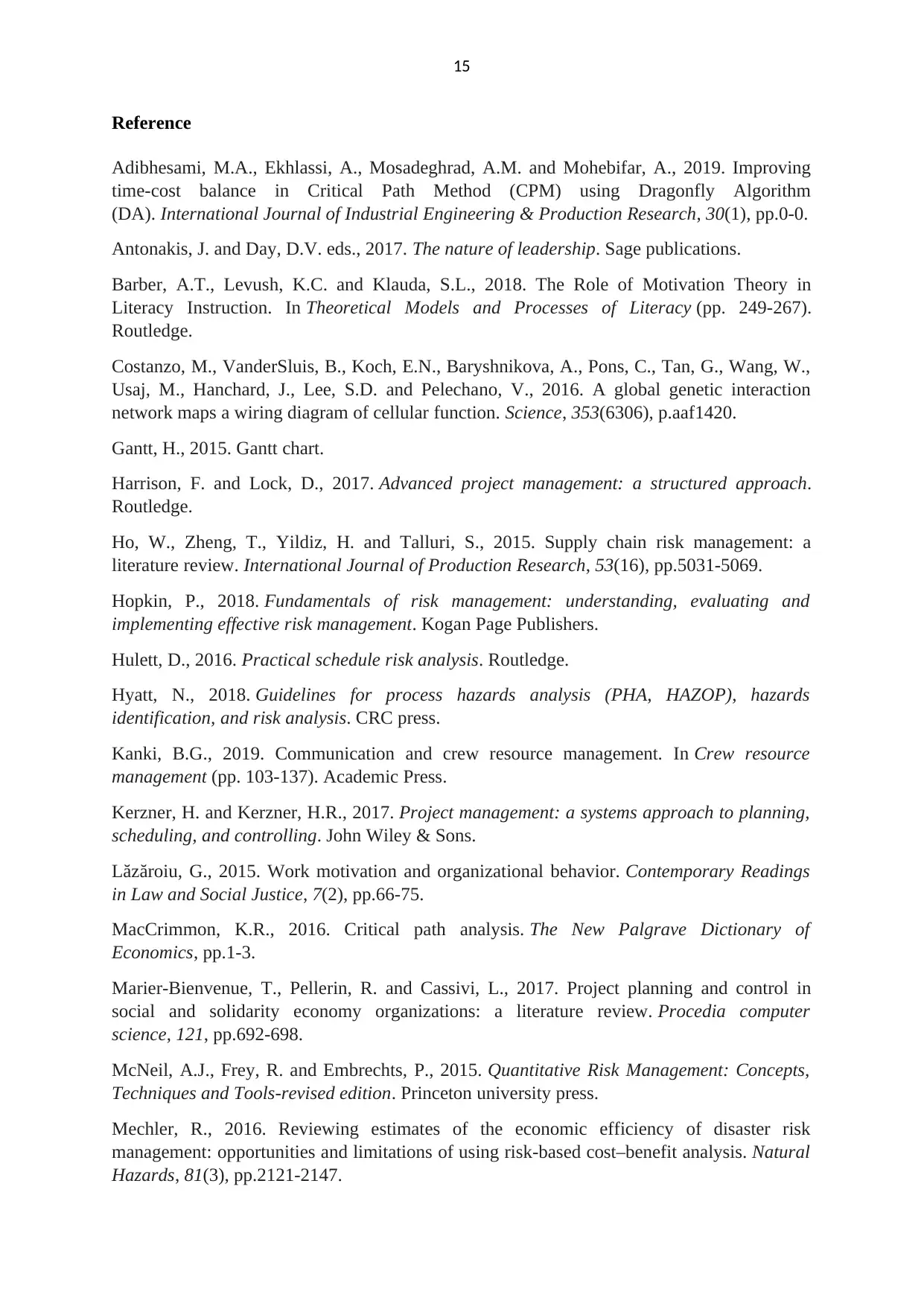
15
Reference
Adibhesami, M.A., Ekhlassi, A., Mosadeghrad, A.M. and Mohebifar, A., 2019. Improving
time-cost balance in Critical Path Method (CPM) using Dragonfly Algorithm
(DA). International Journal of Industrial Engineering & Production Research, 30(1), pp.0-0.
Antonakis, J. and Day, D.V. eds., 2017. The nature of leadership. Sage publications.
Barber, A.T., Levush, K.C. and Klauda, S.L., 2018. The Role of Motivation Theory in
Literacy Instruction. In Theoretical Models and Processes of Literacy (pp. 249-267).
Routledge.
Costanzo, M., VanderSluis, B., Koch, E.N., Baryshnikova, A., Pons, C., Tan, G., Wang, W.,
Usaj, M., Hanchard, J., Lee, S.D. and Pelechano, V., 2016. A global genetic interaction
network maps a wiring diagram of cellular function. Science, 353(6306), p.aaf1420.
Gantt, H., 2015. Gantt chart.
Harrison, F. and Lock, D., 2017. Advanced project management: a structured approach.
Routledge.
Ho, W., Zheng, T., Yildiz, H. and Talluri, S., 2015. Supply chain risk management: a
literature review. International Journal of Production Research, 53(16), pp.5031-5069.
Hopkin, P., 2018. Fundamentals of risk management: understanding, evaluating and
implementing effective risk management. Kogan Page Publishers.
Hulett, D., 2016. Practical schedule risk analysis. Routledge.
Hyatt, N., 2018. Guidelines for process hazards analysis (PHA, HAZOP), hazards
identification, and risk analysis. CRC press.
Kanki, B.G., 2019. Communication and crew resource management. In Crew resource
management (pp. 103-137). Academic Press.
Kerzner, H. and Kerzner, H.R., 2017. Project management: a systems approach to planning,
scheduling, and controlling. John Wiley & Sons.
Lăzăroiu, G., 2015. Work motivation and organizational behavior. Contemporary Readings
in Law and Social Justice, 7(2), pp.66-75.
MacCrimmon, K.R., 2016. Critical path analysis. The New Palgrave Dictionary of
Economics, pp.1-3.
Marier-Bienvenue, T., Pellerin, R. and Cassivi, L., 2017. Project planning and control in
social and solidarity economy organizations: a literature review. Procedia computer
science, 121, pp.692-698.
McNeil, A.J., Frey, R. and Embrechts, P., 2015. Quantitative Risk Management: Concepts,
Techniques and Tools-revised edition. Princeton university press.
Mechler, R., 2016. Reviewing estimates of the economic efficiency of disaster risk
management: opportunities and limitations of using risk-based cost–benefit analysis. Natural
Hazards, 81(3), pp.2121-2147.
Reference
Adibhesami, M.A., Ekhlassi, A., Mosadeghrad, A.M. and Mohebifar, A., 2019. Improving
time-cost balance in Critical Path Method (CPM) using Dragonfly Algorithm
(DA). International Journal of Industrial Engineering & Production Research, 30(1), pp.0-0.
Antonakis, J. and Day, D.V. eds., 2017. The nature of leadership. Sage publications.
Barber, A.T., Levush, K.C. and Klauda, S.L., 2018. The Role of Motivation Theory in
Literacy Instruction. In Theoretical Models and Processes of Literacy (pp. 249-267).
Routledge.
Costanzo, M., VanderSluis, B., Koch, E.N., Baryshnikova, A., Pons, C., Tan, G., Wang, W.,
Usaj, M., Hanchard, J., Lee, S.D. and Pelechano, V., 2016. A global genetic interaction
network maps a wiring diagram of cellular function. Science, 353(6306), p.aaf1420.
Gantt, H., 2015. Gantt chart.
Harrison, F. and Lock, D., 2017. Advanced project management: a structured approach.
Routledge.
Ho, W., Zheng, T., Yildiz, H. and Talluri, S., 2015. Supply chain risk management: a
literature review. International Journal of Production Research, 53(16), pp.5031-5069.
Hopkin, P., 2018. Fundamentals of risk management: understanding, evaluating and
implementing effective risk management. Kogan Page Publishers.
Hulett, D., 2016. Practical schedule risk analysis. Routledge.
Hyatt, N., 2018. Guidelines for process hazards analysis (PHA, HAZOP), hazards
identification, and risk analysis. CRC press.
Kanki, B.G., 2019. Communication and crew resource management. In Crew resource
management (pp. 103-137). Academic Press.
Kerzner, H. and Kerzner, H.R., 2017. Project management: a systems approach to planning,
scheduling, and controlling. John Wiley & Sons.
Lăzăroiu, G., 2015. Work motivation and organizational behavior. Contemporary Readings
in Law and Social Justice, 7(2), pp.66-75.
MacCrimmon, K.R., 2016. Critical path analysis. The New Palgrave Dictionary of
Economics, pp.1-3.
Marier-Bienvenue, T., Pellerin, R. and Cassivi, L., 2017. Project planning and control in
social and solidarity economy organizations: a literature review. Procedia computer
science, 121, pp.692-698.
McNeil, A.J., Frey, R. and Embrechts, P., 2015. Quantitative Risk Management: Concepts,
Techniques and Tools-revised edition. Princeton university press.
Mechler, R., 2016. Reviewing estimates of the economic efficiency of disaster risk
management: opportunities and limitations of using risk-based cost–benefit analysis. Natural
Hazards, 81(3), pp.2121-2147.
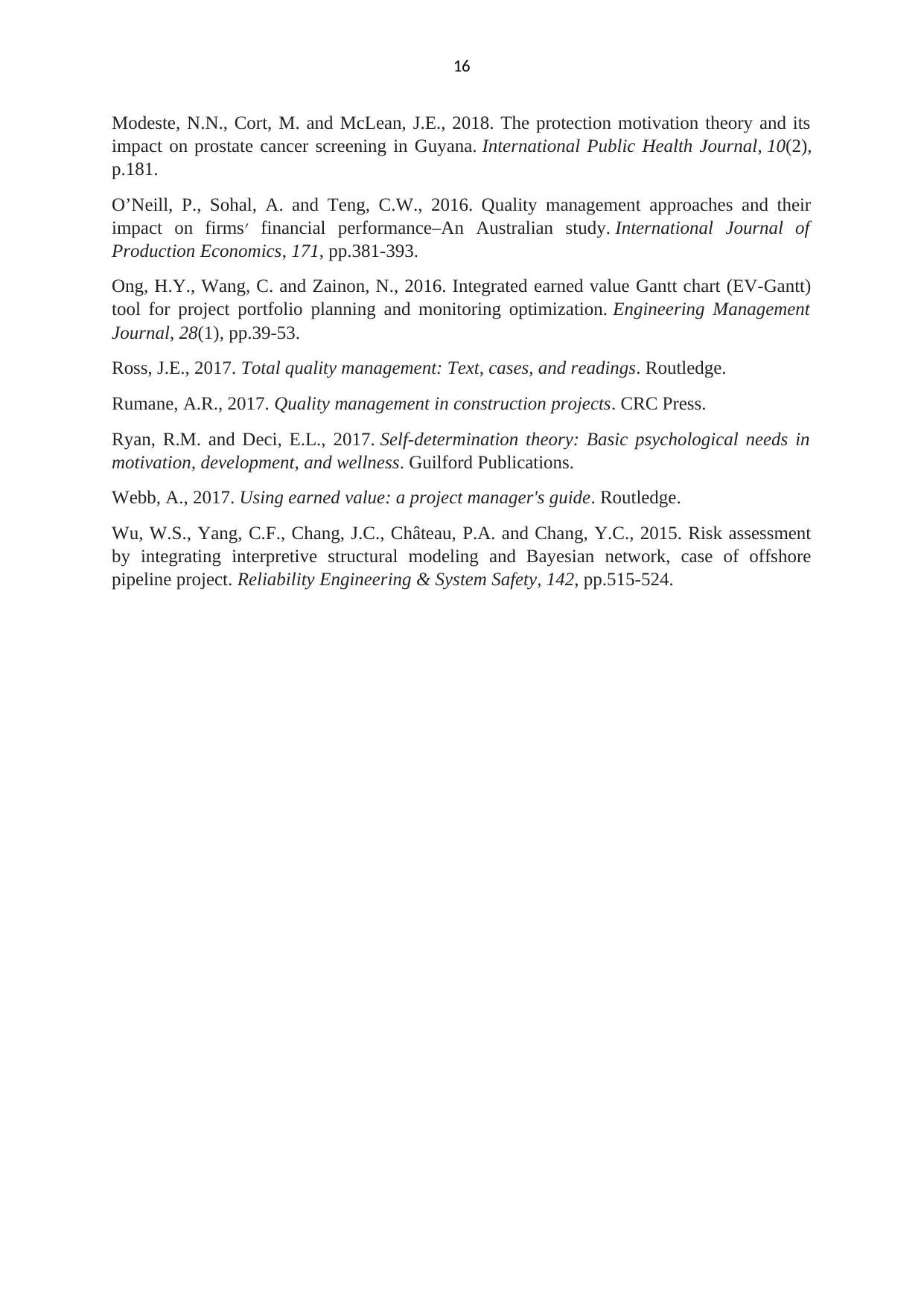
16
Modeste, N.N., Cort, M. and McLean, J.E., 2018. The protection motivation theory and its
impact on prostate cancer screening in Guyana. International Public Health Journal, 10(2),
p.181.
O’Neill, P., Sohal, A. and Teng, C.W., 2016. Quality management approaches and their
impact on firms׳ financial performance–An Australian study. International Journal of
Production Economics, 171, pp.381-393.
Ong, H.Y., Wang, C. and Zainon, N., 2016. Integrated earned value Gantt chart (EV-Gantt)
tool for project portfolio planning and monitoring optimization. Engineering Management
Journal, 28(1), pp.39-53.
Ross, J.E., 2017. Total quality management: Text, cases, and readings. Routledge.
Rumane, A.R., 2017. Quality management in construction projects. CRC Press.
Ryan, R.M. and Deci, E.L., 2017. Self-determination theory: Basic psychological needs in
motivation, development, and wellness. Guilford Publications.
Webb, A., 2017. Using earned value: a project manager's guide. Routledge.
Wu, W.S., Yang, C.F., Chang, J.C., Château, P.A. and Chang, Y.C., 2015. Risk assessment
by integrating interpretive structural modeling and Bayesian network, case of offshore
pipeline project. Reliability Engineering & System Safety, 142, pp.515-524.
Modeste, N.N., Cort, M. and McLean, J.E., 2018. The protection motivation theory and its
impact on prostate cancer screening in Guyana. International Public Health Journal, 10(2),
p.181.
O’Neill, P., Sohal, A. and Teng, C.W., 2016. Quality management approaches and their
impact on firms׳ financial performance–An Australian study. International Journal of
Production Economics, 171, pp.381-393.
Ong, H.Y., Wang, C. and Zainon, N., 2016. Integrated earned value Gantt chart (EV-Gantt)
tool for project portfolio planning and monitoring optimization. Engineering Management
Journal, 28(1), pp.39-53.
Ross, J.E., 2017. Total quality management: Text, cases, and readings. Routledge.
Rumane, A.R., 2017. Quality management in construction projects. CRC Press.
Ryan, R.M. and Deci, E.L., 2017. Self-determination theory: Basic psychological needs in
motivation, development, and wellness. Guilford Publications.
Webb, A., 2017. Using earned value: a project manager's guide. Routledge.
Wu, W.S., Yang, C.F., Chang, J.C., Château, P.A. and Chang, Y.C., 2015. Risk assessment
by integrating interpretive structural modeling and Bayesian network, case of offshore
pipeline project. Reliability Engineering & System Safety, 142, pp.515-524.
1 out of 16
Related Documents
Your All-in-One AI-Powered Toolkit for Academic Success.
+13062052269
info@desklib.com
Available 24*7 on WhatsApp / Email
![[object Object]](/_next/static/media/star-bottom.7253800d.svg)
Unlock your academic potential
© 2024 | Zucol Services PVT LTD | All rights reserved.





